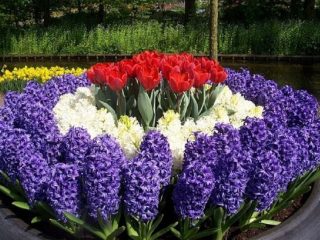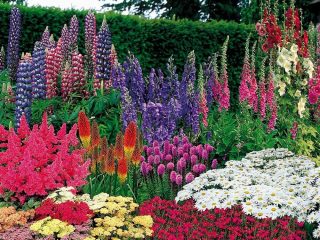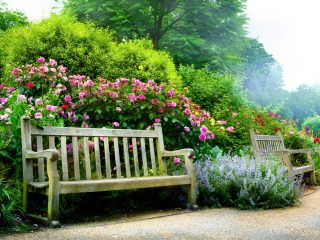Content
A beautiful flower garden is a mandatory attribute of every summer cottage. In addition to performing a decorative function, flowers are able to attract insects to the site, which are so necessary for pollinating fruit trees and vegetable crops. Seeds of the required flowers can be purchased separately, or can be purchased in a ready-made combination. Such prefabricated sets of flower seeds include the “Flower Cocktail” mixture of low perennials, which will be discussed in this article.
Mixture characteristics
"Flower Cocktail" is a specially created mixture of low perennial flowers, ideal for edgings and lawn beds. The height of each flower included in the “Flower Cocktail” will not exceed 30 centimeters. All flowers included in this mixture have different shapes and colors. In addition, they have a fairly long flowering period, which covers almost the entire summer.
Based on the photo from the packaging of perennial seeds, as well as on feedback from gardeners, we have compiled a rough list of flowers included in the “Flower Cocktail” mixture.
Decorative bow
Decorative onion or allium is one of the most unpretentious and spectacular perennial flowers. Some of its species can even be eaten.
Allium looks very impressive during flowering, which lasts from late spring to late July. At this time, the decorative onion sends up a long stem, on which a spherical umbrella inflorescence is located. But even after flowering ends, the decorative function of this relative of the onion does not disappear. Its inflorescences dry out and become like large dandelions. Maybe that’s why the decorative bow attracts all the kids.
Primrose
This perennial low-growing flower is one of the most beautiful representatives of the Primrose family. In addition, primrose is one of the earliest perennials. The flowering period of primrose begins in early spring and ends at the end of summer. In total, just over 500 species of these low-growing perennials are known, some of which are listed in the Red Book.
In addition to early and abundant flowering, primrose has a number of distinctive advantages:
- winter hardiness;
- rapid reproduction both by seeds and vegetatively;
- ease of cultivation and care;
- decorative foliage.
Primrose looks great not only in ridges and borders, but also on alpine slides.
Smolevka
This low-growing perennial flower belongs to the Carnation family. The resinous plant got its name due to its resinous, sticky stems that creep slightly along the ground. About 150 species of resin can grow on the territory of Russia, despite the fact that there are more than 500 of them in total.
A single resin looks rather inconspicuous due to the small size of the flowers. But multiple resin plants, forming a carpet on the ground, look very impressive during flowering. The resin flower blooms for quite a long time from May to early autumn. At the same time, its distinctive feature is night flowering.
Smolevka is not only a very beautiful flower, but also very useful. Since ancient times, it has been used to treat nervous disorders and inflammatory processes.
Phlox subulate
The awl-shaped phlox is a creeping ground cover plant with a height of 16 to 18 centimeters. This phlox got its name because of its narrow, pointed leaf plate, similar to small “awls.”
During the season, the awl-shaped phlox blooms twice:
- from May to early June;
- from August to September.
The varied colors of this perennial flower include pink, white, purple and more. The awl-shaped phlox is very low maintenance, making it one of the best flowers for beginning gardeners.
Recommendations for cultivation
A mixture of low-growing perennial flowers “Flower Cocktail” can be grown in two ways:
- through seedlings at the end of April.
- sowing seeds in the ground in early May.
In both cases, the seeds of perennial flowers are carefully scattered over the surface of the ground and lightly sprinkled. The first shoots of perennials will begin to appear 2 weeks after planting. When the young flower shoots get stronger, they need to be pruned. If perennial seedlings are planted immediately in a permanent place, then they need to be thinned out so that there is from 15 to 20 centimeters between the plants.
Perennials should be watered sparingly as the top layer of soil dries. You can also fertilize perennials several times a season with any organic or mineral fertilizer.














Pansies and white Smolevka bloomed from this bag. Nothing like the picture on the package. We couldn’t recognize one plant (it didn’t bloom). Let’s see what happens this year.